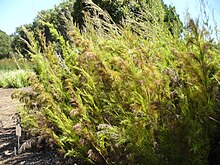Restio
| Restio | |
|---|---|

| |
| Scientific classification | |
| Kingdom: | Plantae |
| Clade: | Tracheophytes |
| Clade: | Angiosperms |
| Clade: | Monocots |
| Clade: | Commelinids |
| Order: | Poales |
| Family: | Restionaceae |
| Genus: | Restio Rottb. 1772 conserved name, not L. 1767[1] |
| Type species | |
| Restio dichotomus | |
| Synonyms[1][4] | |
| |
Restio is a genus of flowering plants within the family Restionaceae, described in 1772.[5][3] The entire genus is endemic to South Africa (Cape Province and KwaZulu-Natal).[4]
In common with a number of other genera in the Restionaceae, restios are widely cultivated for use as garden ornamentals for their attractive nodular foliage. They are mildly frost hardy.
- Species[4]
Many species formerly included within the genus Restio are now classified into a number of other genera including Acion, Baloskion, and Eurychorda.
References[]
- ^ a b Tropicos, Restio L.
- ^ lectotype designated by Mc Vaugh, Taxon 17: 85-87 (19??)
- ^ a b Tropicos, Restio Rottb.
- ^ a b c "World Checklist of Selected Plant Families: Royal Botanic Gardens, Kew". wcsp.science.kew.org. Retrieved 2018-07-20.
- ^ Rottbøll, Christen Friis. 1772. Descriptiones Plantarum Rariorum 9
Further reading[]
- Dorrat-Haaksma, Els; Linder, Hans Peter (2012). Restios of the Fynbos (2 ed.). Cape Town: Struik Nature.
Categories:
- Restionaceae
- Endemic flora of South Africa
- Flora of KwaZulu-Natal
- Flora of the Cape Provinces
- Fynbos
- Poales genera
- Poales stubs